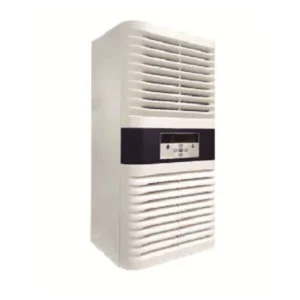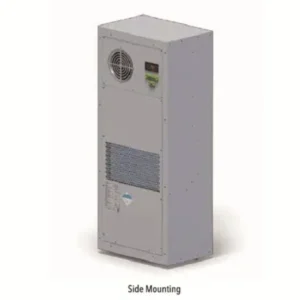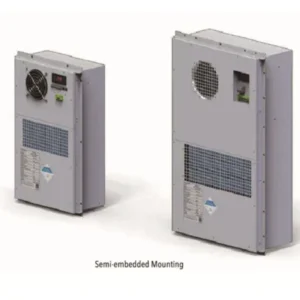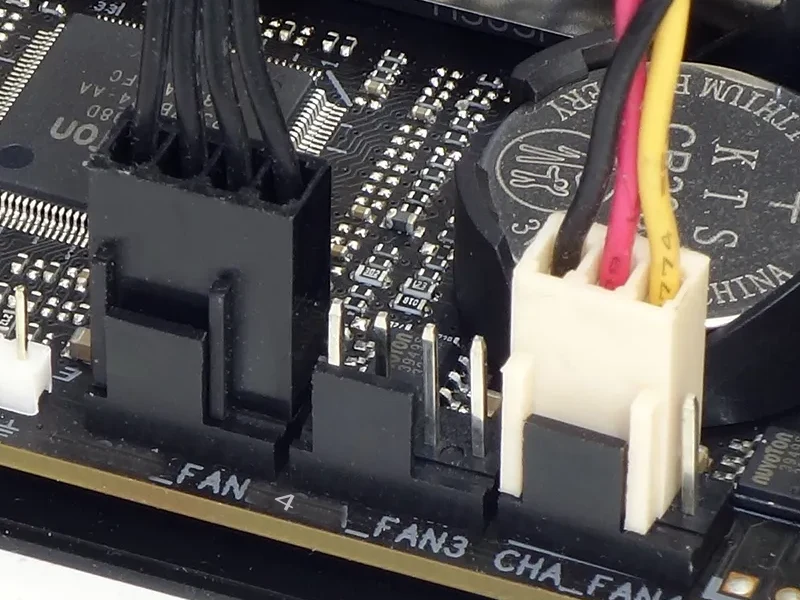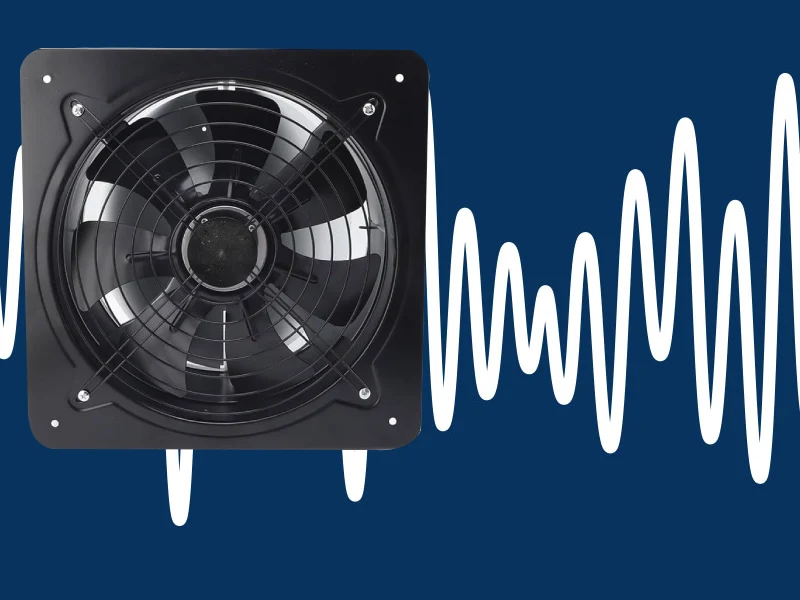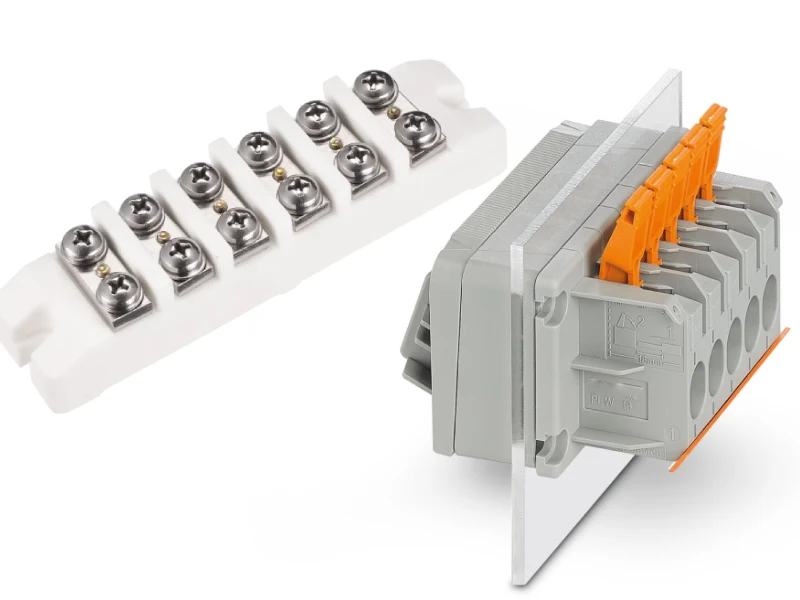Choosing the best location for your enclosure air conditioner makes a big difference in how well your equipment runs. If you pick the right spot for your air conditioning unit, you help protect your enclosure and save energy.
Placing your air conditioning unit in the best location keeps things cool and prevents costly breakdowns. Linkwell gives you reliable options for enclosure air conditioner mounting locations, so you can keep your enclosure safe and your air conditioning unit working at its best.
Location for Enclosure Air Conditioners Key Takeaways
- Choose your air conditioner location based on your enclosure’s size, shape, and material to ensure proper cooling and fit.
- Consider environmental factors like indoor or outdoor placement, dust, moisture, and heat sources to protect your unit and enclosure.
- Match the air conditioner’s cooling capacity to the total heat load inside and outside the enclosure to avoid overheating or wasted energy.
- Allow enough clearance and airflow around the unit to keep it running efficiently and prevent damage from blocked vents or obstructions.
- Mechanical unit neat enclosure Plan for easy access to the unit for maintenance, including filter cleaning, to extend its life and keep your equipment safe.
Recommended products
Best Location Factors
Enclosure Design
When you start thinking about enclosure air conditioner mounting locations, the design of your enclosure comes first. The size and shape of your enclosure decide what kind of air conditioning unit you can use and where you can put it. If you have a large enclosure, you need an air conditioning unit with enough cooling capacity to keep everything safe. Smaller enclosures might not have space for a side-mount or recessed unit, so you may need a top-mount or even a door-mount option.
Linkwell offers flexible mounting choices, including side, top, and door-mount air conditioning units. This flexibility means you can always find the best location for your setup, whether you have a single-door cabinet, a double-door panel, or a rack system. If your enclosure is shallow, you might want a slim side-mount unit that fits tight spaces. For rack enclosures, a rack-mount air conditioning unit works best because it fits right into the rails.
The shape and material of your enclosure also affect cooling. A dark-colored or metal enclosure absorbs more heat, which means you need more cooling capacity. Closed-loop cooling systems work well for sealed enclosures because they keep outside air out and maintain a steady temperature inside. Always measure your enclosure and check the available mounting space before you choose your air conditioning unit.
Tip: Always check the weight and stability of your enclosure before mounting a heavy air conditioning unit on a door or top panel. Make sure the hinges and footing can handle the extra load.
Environmental Conditions
The environment around your enclosure plays a huge role in picking the best location for your air conditioning unit. You need to think about whether your enclosure sits indoors or outdoors. Indoor environments usually have less dust and moisture, but you still need to protect against oil, dirt, and accidental spills. Outdoor setups face rain, snow, sun, and even salt air if you’re near the coast.
Here are some key environmental factors that affect enclosure air conditioner mounting locations:
- Heat load from both inside and outside the enclosure
- Temperature differences between the inside and outside air
- Humidity and risk of condensation
- Dust, dirt, and airborne particles
- Exposure to water, snow, or high-pressure cleaning
- Solar exposure and nearby heat sources
If you install your air conditioning unit outdoors, you need an outdoor ac unit with the right protection. Look for models with IP54, IP65, or NEMA 4/4X ratings. These ratings mean your air conditioning unit can handle rain, dust, and corrosion. For indoor enclosures, NEMA 12 is a common choice because it protects against dust and oil.
| NEMA Rating | Environment | Protection Features | Typical Use Case |
|---|---|---|---|
| NEMA 12 | Indoor | Protection against dust, oil, and dripping non-corrosive liquids | Manufacturing plants, indoor enclosures |
| NEMA 3R | Outdoor | Protection against rain, sleet, ice formation | Outdoor telecom and utility boxes |
| NEMA 4 | Indoor/Outdoor | Protection against windblown dust, rain, splashing water, hose-directed water | Washdown or outdoor environments |
| NEMA 4X | Indoor/Outdoor | Same as NEMA 4 plus corrosion resistance | Harsh outdoor or coastal areas |
Note: Always match your air conditioning unit’s rating to your environment. This keeps your equipment safe and your cooling system running smoothly.
Mechanical Unit Neat Enclosure Equipment Heat Load
You can’t ignore the heat load when choosing enclosure air conditioner mounting locations. Every piece of equipment inside your enclosure gives off heat. If you don’t size your air conditioning unit correctly, you risk overheating or wasting energy.
Here’s a simple way to figure out your total heat load:
- Add up the heat from all the equipment inside your enclosure. Use the manufacturer’s data or electrical ratings.
- Include extra heat from outside sources, like sunlight or nearby machines.
- Decide on the maximum safe temperature for your equipment.
- Check the highest and lowest temperatures your enclosure will face, whether it’s indoor or outdoor.
- Use a BTU/hr calculator to find the cooling capacity you need.
- Don’t pick an air conditioning unit that’s too big or too small. Oversized units waste energy, while undersized ones run nonstop and can’t provide sufficient cooling.
- If you’re not sure, ask a specialist or use Linkwell’s support to get the right fit.
If you want sufficient cooling, always match your air conditioning unit’s cooling capacity to the total heat load. This keeps your enclosure safe and your equipment running longer.
Mounting Location for Enclosure Air Conditioners: Airflow & Clearance Tips
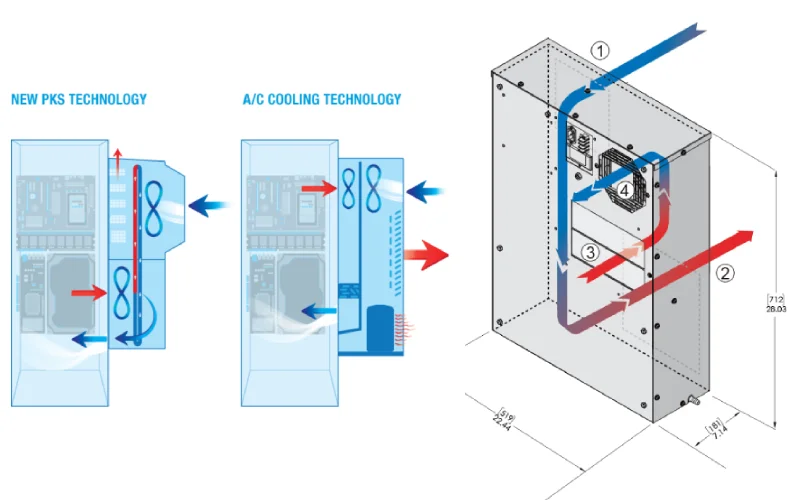
Proper Ventilation
When you install the unit, you want to make sure your air conditioning unit gets enough fresh air. Sufficient clearance around the air conditioning unit is not just a suggestion—it is a must for good performance. If you block the intake or exhaust, the unit cannot move air as it should. Most manufacturers recommend at least two inches of clearance around any intake or exhaust. For outdoor installations, you should keep at least one foot on all sides, but two to three feet is even better. You also need at least five feet of open space above the unit. This setup helps your air conditioning unit breathe and keeps it from overheating.
If you skip proper ventilation, you risk more than just poor cooling. Restricted airflow makes your air conditioning unit work harder, which can lead to more repairs and a shorter lifespan. You might see hot spots inside your enclosure or even have the unit shut off and turn on too often. That is why you should always plan your installation with airflow in mind.
Tip: Place air inlets low and outlets high to use natural convection. This simple trick helps move hot air out and brings cool air in.
Linkwell designs its air conditioning units for easy installation and optimal airflow. You get features like smart fan placement and washable filters, making it simple to keep your system running smoothly.
Avoiding Obstructions
Obstructions can interfere with airflow and reduce the cooling power of your air conditioning unit. When you install the unit, keep it away from walls, bushes, or fences that block air movement. Inside the enclosure, watch out for cables and large components that might block the airflow path. Good cable management and smart component placement help a lot.
- Keep intake and exhaust areas clear.
- Use ducting to direct air to hot spots if needed.
- Regularly check for dust or debris that could block vents or filters.
When installing air conditioning, always think about how air will move in and out. Sufficient clearance and a clear path for airflow help your equipment last longer and work better.
Mounting Location for Enclosure Air Conditioners: Sunlight & Heat Sources
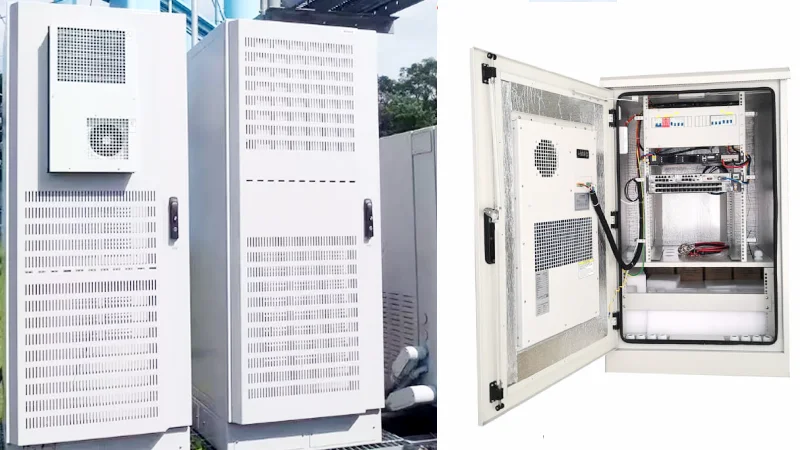
Direct Sunlight
When you pick a spot for your air conditioning unit, you want to keep it out of direct sunlight. Sunlight can heat up your enclosure much more than you might expect. For example, a dark green metal enclosure sitting outside reached over 105°F inside, even though the air outside was only 85°F. That’s a jump of about 20°F just from the sun. If your enclosure sits in the sun all day, the cooling system has to work much harder.
Outdoor enclosures absorb solar heat, especially if they have dark colors or metal surfaces. You can lower the temperature inside by choosing a shaded spot or using a location close to your house that blocks the sun. If you can’t avoid sunlight, try adding a shade or a protective cover. This simple step helps your air conditioning unit run more efficiently and keeps your equipment safe.
Linkwell’s outdoor ac unit models come with features built for tough environments. You get weatherproof designs, high IP ratings, and corrosion-resistant materials. These units handle rain, dust, and harsh sunlight without missing a beat. Here are some protective features you’ll find:
- Stainless steel or aluminum construction for corrosion resistance.
- Weatherproof seals and high IP ratings to block dust and water.
- Heavy-duty components for extreme temperatures.
- Secure mounting to keep out contaminants.
- Advanced cooling technology for steady temperature control.
- Energy-efficient designs for reliable outdoor performance.
If you want your cooling system to last, always avoid heat sources like direct sunlight when you choose a mounting spot.
Nearby Equipment
Heat from nearby machines can also raise the temperature inside your enclosure. If you place your air conditioning unit next to a furnace, oven, or other heat-generating equipment, the cooling load goes up. The air around your enclosure gets warmer, so your cooling system has to work harder to keep things safe.
You should plan your installation to avoid heat sources. Try these best practices:
- Pick a cool, dry spot for your enclosure.
- Use shades or barriers to block heat from nearby equipment.
- Seal the enclosure well to keep hot air out.
- Optimize airflow inside for better cooling.
Nearby heat-generating equipment increases the heat load and raises the ambient temperature. This means you need a stronger cooling solution. Linkwell’s outdoor ac unit models are designed for these tough spots. They keep your enclosure cool, even when the environment gets hot.
Good planning helps you save on cooling costs and keeps your equipment running longer.
Accessibility & Maintenance
Service Access
When you choose a spot for your air conditioning unit, think about how easy it will be to reach for service. You don’t want to struggle every time you need to check the controls or clean the inside. If you pick a location with clear access, you can handle routine tasks quickly and safely. Wall-mounted units make this even easier because you can reach filters and controls without climbing or squeezing into tight spaces.
Linkwell designs its air conditioning units with service in mind. Many models have removable covers, so you can get to the front-facing controls and components without hassle. You’ll also find that the micro-channel condenser design helps reduce clogging, making cleaning much simpler. This means less downtime and fewer headaches for you.
Tip: Always leave enough space around your enclosure for doors to open fully and for you to reach all parts of the air conditioning unit. Good planning now saves you time later.
Filter Cleaning
Keeping the filters clean is one of the most important jobs you’ll do. The air conditioning unit pulls air through special filters that trap dust and particles. If these filters get clogged, airflow drops and the system has to work harder. That can lead to higher energy bills, uneven cooling, and even damage to your enclosure’s electronics.
You should check the filters often, especially if your enclosure sits in a dusty or busy area. There’s no set schedule for cleaning—just look for dust or dirt building up. Washable filters need a good rinse, while disposable ones should be replaced with the same type. Regular filter checks help your air conditioning unit run better and last longer.
- Clean filters mean better cooling and lower costs.
- Skipping filter maintenance can cause breakdowns and shorten the life of your equipment.
- Good air quality inside your enclosure protects sensitive electronics.
Note: Make filter checks part of your routine. A few minutes now can prevent big problems later.
Protection & Compliance
Debris & Pets
You want your enclosure air conditioner to last, so you need to protect it from more than just the weather. In many places, dust, dirt, and even small animals can sneak into your enclosure and cause trouble. Here are some common threats you might face:
- Airborne dust and dirt, especially in factories or desert areas
- Flour or food particles in processing plants
- Corrosive chemical vapors in industrial zones
- Salt air near the coast
- Water from rain, snow, or hose cleaning
- High humidity and extreme temperatures
- Curious pets or wildlife looking for shelter
If you let these hazards get inside, they can clog filters, cause overheating, or even damage sensitive electronics. Closed-loop cooling systems help by keeping outside air out. Sealed designs and corrosion-resistant materials add another layer of protection. Some enclosures use rain hoods, special coatings, or even vibration-resistant parts to handle tough environments. You can also find models with external controls, so you don’t have to open the enclosure and risk letting in debris or animals.
Tip: Always check for gaps or loose panels. Even a small opening can let in dust or pests.
Standards & Ratings
You need to make sure your enclosure air conditioner meets the right standards for your environment. NEMA and IP ratings tell you how much protection your equipment has against dust, water, and corrosion. Picking the right rating keeps your enclosure safe and your electronics running.
Here’s a quick look at common ratings:
| NEMA Rating | IP Rating | Best For |
|---|---|---|
| NEMA 12 | IP52 | Indoor, dust, oil, light splashes |
| NEMA 3R | IP24 | Outdoor, rain, sleet, snow |
| NEMA 4 | IP66 | Outdoor, water jets, dust |
| NEMA 4X | IP66 | Outdoor, corrosion, harsh areas |
Linkwell’s enclosure air conditioners meet or exceed these standards. They use stainless steel and special coatings to fight corrosion. Every unit goes through tough lab tests and holds certifications like UL, CE, and CSA. You get peace of mind knowing your enclosure is protected, even in the harshest places.
Tips for the Right Location
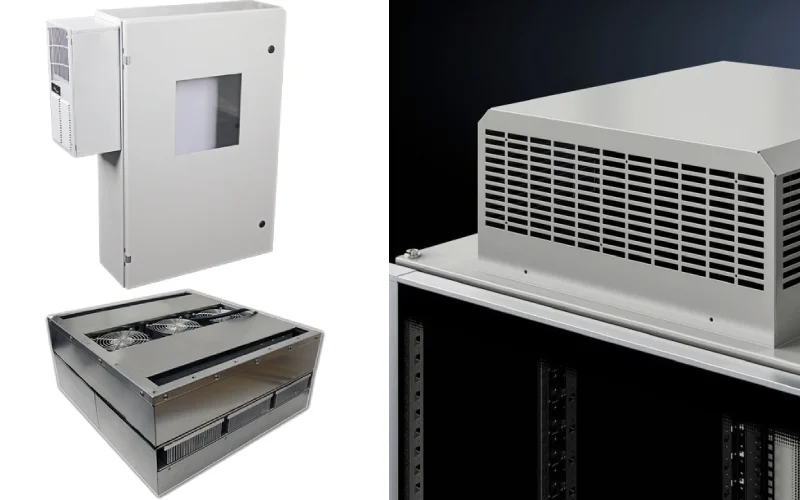
Mounting Styles
Choosing the right location for your enclosure air conditioner starts with understanding the different mounting styles. Each style has its own strengths and challenges. Picking the best one depends on your enclosure type, available space, and the environment where you plan to install the unit.
Here’s a quick look at the most common mounting styles:
| Mounting Style | Advantages | Disadvantages |
|---|---|---|
| Side-Mount, side mount air conditioner | Balanced airflow; flexible orientation; popular in many industries | Needs space inside the enclosure; may block internal components if not planned well |
| Flush-Mount | Saves space inside; easy maintenance from outside | Fully exposed to dust and weather; may need extra support |
| Recessed Mount | Keeps the unit protected; clean, professional look | Takes up space inside; harder to reach for service |
| Top-Mount, top mount ac | Great when side space is tight; uses rising heat for efficient cooling | Needs good condensate management to avoid water issues |
| Rack-Mount, rack mount air conditioning unit | Saves space; cools IT equipment well | Only fits certain racks; needs careful airflow planning |
You want to match the mounting style to your enclosure and your application. For example, top-mount air conditioners work well when you have limited side space. They use the natural rise of hot air to boost cooling. Just make sure you have a good system for handling condensation, so you don’t risk water damage.
If you have a shallow enclosure, a slim side-mount unit can fit where others won’t. Rack-mount units are perfect for IT and telecom setups, sliding right into standard racks. Flush-mount and recessed options give you a clean look and save space, but you need to plan for easy access during maintenance.
Tip: Always check the physical size of your air conditioner and your enclosure before you start installation. This helps you avoid mounting and installation issues, like poor fit or blocked airflow.
When you select a mounting style, think about the enclosure’s size, the type of equipment inside, and how much space you have around it. Modular enclosures with removable panels make installation and maintenance much easier. If you need to check your equipment often, transparent doors or panels can help you monitor things without opening the enclosure.
Professional Advice
You might feel confident picking a mounting style and location, but some situations call for expert help. Complex installations, unique environments, or high-value equipment deserve extra attention. Here are some of the best tips for choosing a location and making sure your enclosure air conditioner mounting locations work for you:
- Calculate the heat load for your enclosure. This helps you pick the right cooling capacity.
- Choose energy-efficient air conditioners with features like rotary compressors and digital controllers.
- Make sure your enclosure meets the right NEMA or IP rating for your environment.
- Plan for easy access to filters and controls for regular maintenance.
- Keep intake and exhaust areas clear for steady airflow.
- Use condensate removal systems to prevent water buildup.
- Perform regular filter checks and cleanings, especially in dusty areas.
Note: Many people make mistakes by not checking the fit between the air conditioner and the enclosure, or by placing cutouts in the wrong spot. Always double-check measurements and compatibility before you install the unit.
If you’re not sure about the right location or mounting style, reach out to a professional or contact Linkwell. Their team can help you with installation, product selection, and even custom solutions for tricky environments. Getting advice early can save you time, money, and headaches down the road.
Tip: For the best results, combine expert advice with regular maintenance. This keeps your enclosure air conditioner running smoothly and protects your valuable equipment.
By following these tips and considering your enclosure, environment, and equipment, you can find the right location and mounting style for your needs. This ensures reliable cooling, easy maintenance, and long-term protection for your systems.
You want your enclosure air conditioner to work its best, so focus on airflow, protection, easy access, and meeting standards. Pick the best location by checking for clear air paths and safe surroundings. Linkwell stands out with fast responses, expert help, and flexible options:
- Quick quotes and technical support
- Customization for your needs
- Certified products and easy installation
- Reliable after-sales service
Reach out to Linkwell if you need advice or want to explore solutions for your project.
FAQ
How do I know which mounting style fits my enclosure?
You need to check your enclosure’s size, shape, and available space. Side-mount works for most cabinets. Top-mount helps when side space is tight. Rack-mount fits IT racks. If you’re unsure, ask Linkwell for advice.
How often should I clean the air conditioner filter?
You should clean the filter every three months in clean areas. If your enclosure sits in a dusty spot, check and clean it monthly. Regular cleaning keeps airflow strong and protects your equipment.
Can I install an enclosure air conditioner outdoors?
Yes, you can. Just pick a unit with the right IP or NEMA rating. Linkwell offers outdoor-ready models that handle rain, dust, and harsh weather. Always check the product specs before you install.
What if my enclosure is exposed to direct sunlight?
Try to place your enclosure in a shaded area. If that’s not possible, use a sun shield or pick a Linkwell unit with high heat resistance. Direct sunlight increases the cooling load and can stress your system.
Who can help me choose the best location or unit?
You can reach out to Linkwell’s support team. They offer expert advice, quick quotes, and help with installation. If you have a unique setup, their specialists can suggest custom solutions.
Conclusion
In electrical, control, and telecom cabinets, choosing the right axial filter fan or enclosure cooling fan is essential for maintaining safe operating temperatures. These specialized fans ensure stable performance, prevent overheating, and extend equipment life.
By understanding industry terminology and specifications, you can select the perfect cooling solution. Linkwell provides high-quality, custom-designed cabinet fans tailored to your application, ensuring precise airflow, durability, and reliability.

